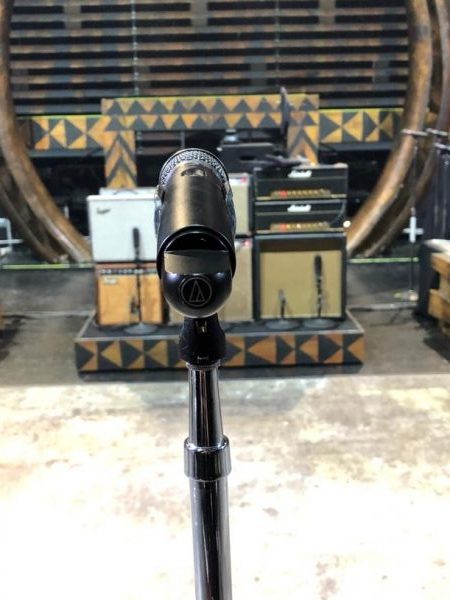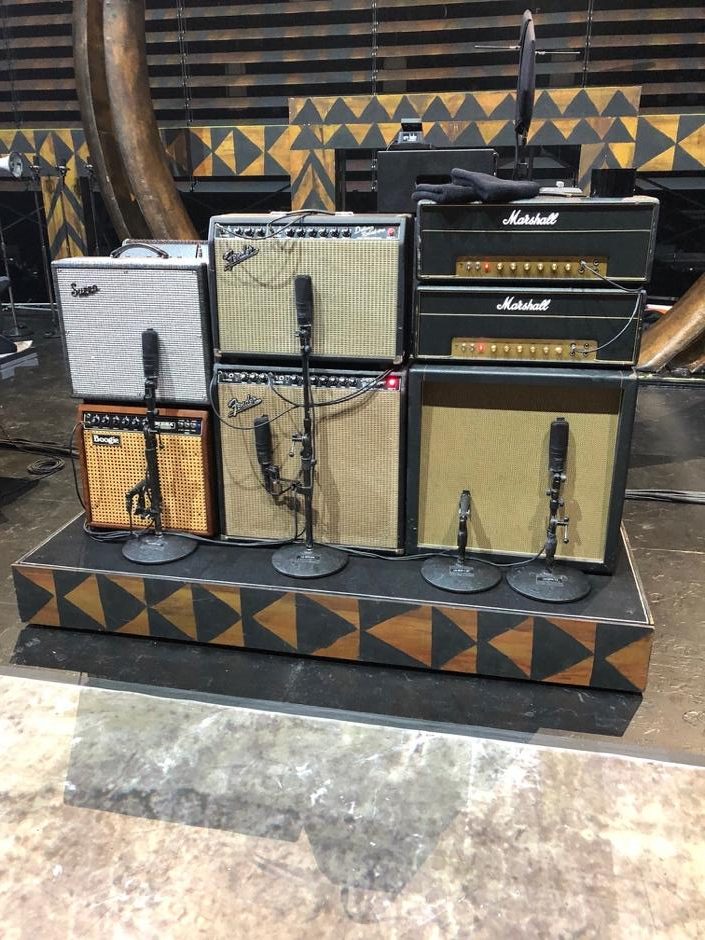Miking live performances can be a challenge for sound engineers, but after decades on the road, it can quickly become second nature. We recently sat down with Laurie Quigley, who has been a sound engineer for over 40 years and has traveled all over the world with a variety of artists, to learn more about his career in sound production. For the last 15 years, Quigley has toured with Lenny Kravitz, using a number of A-T mics on stage. Continue reading to learn more about Quigley’s experience in the industry and the setup he uses for Kravitz!
Could you tell us a little bit about yourself and how you got involved in sound production?
I got involved in the music industry in the mid 70s. My best friend was a guitar player, so wherever he went, I went. When I was 16, he joined a small rock band and I helped them set up their gear. His little rock band got a little bigger, and they brought a small sound system which I maintained and played around with, learning what I could. Eventually as the band got bigger, so did the sound system.
In the late 70s I moved to Melbourne for university and started working with other bands and eventually became involved with a Melbourne-based sound company. I worked with several large Australian touring acts, before deciding that I needed to have a look overseas. I went on a 6-month vacation and returned 30 years later! I first spent 3 years in London before moving to the USA for 27 years.
[caption id="attachment_8236" align="aligncenter" width="600"] Laurie Quigley and A-T’s Artist Relations Manager, Roxanne Ricks[/caption]
You've worked with Lenny Kravitz for many years now, providing sound support on tour. How did you end up meeting Lenny and what's it like to work with him?
I have worked with Lenny for 15 years now, early 2004 until present. I met Lenny several times while I was working with Aerosmith and later with KISS. Early 2004, I received a phone call from his management office asking me to hold for Mr. Lenny Kravitz. I thought someone was winding me up, but it was far from a joke. Lenny asked me if I would come and mix his band. I had another week to finish a KISS tour and his talent intrigued me, so I accepted his offer. Lenny is an incredibly nice person, but in a lot of ways, difficult to work for because of his knowledge, since he’s really on top of his live show, especially his audio. Lenny owns several studios and knows audio well. His knowledge keeps me on my toes and has made me a far better sound engineer. When I say difficult, I mean you have to be good every day and be on top of your job, because he knows how things are meant to sound. I thoroughly enjoy my time working with Lenny, hence 15 years and I’m still going.
Aside from Lenny, who are some of your favorite musicians to work with?
Over the years, I have worked with some incredible people. I have been very lucky to never have worked for someone I didn’t get along with or didn’t like. Since moving to the States in 1982, I have worked with Motley Crue, White Snake, Ozzy, Bon Jovi, Cinderella, Tesla, Aerosmith, KISS, and many more.
We hear you're a big fan of the AT4050 microphone, particularly for live applications. What made you choose the AT4050 as your go-to mic?
During my time with Motley Crue in the early 80’s I started looking for large diaphragm mics that could handle large sound pressure levels. I started using kick mics on all my guitar cabinets to great success. Instead of having to move a mic around trying to find a sweet spot, you just put a large diaphragm mic in the center of the cone and tight to the grill cloth.
Over the years I had met and became friends with Joel Singer, he told me about a new company setting up in Cleveland and that I should have a look at some of their product.
I first saw and heard an AT4050 around 25 years ago. I was sold instantly and replaced all my guitar mics with 4050’s shortly after (as soon as I could get enough of them). I flirted with the AT4060 for a while, but returned quickly to the AT4050. I liked the sound of the AT4060 just wasn’t sold on the power supplies. I have compared different mics over the years but have yet to find a better sounding or more reliable microphone.
As for the AT4050, I believe there’s close to 30 on stage.
Laurie Quigley and A-T’s Artist Relations Manager, Roxanne Ricks[/caption]
You've worked with Lenny Kravitz for many years now, providing sound support on tour. How did you end up meeting Lenny and what's it like to work with him?
I have worked with Lenny for 15 years now, early 2004 until present. I met Lenny several times while I was working with Aerosmith and later with KISS. Early 2004, I received a phone call from his management office asking me to hold for Mr. Lenny Kravitz. I thought someone was winding me up, but it was far from a joke. Lenny asked me if I would come and mix his band. I had another week to finish a KISS tour and his talent intrigued me, so I accepted his offer. Lenny is an incredibly nice person, but in a lot of ways, difficult to work for because of his knowledge, since he’s really on top of his live show, especially his audio. Lenny owns several studios and knows audio well. His knowledge keeps me on my toes and has made me a far better sound engineer. When I say difficult, I mean you have to be good every day and be on top of your job, because he knows how things are meant to sound. I thoroughly enjoy my time working with Lenny, hence 15 years and I’m still going.
Aside from Lenny, who are some of your favorite musicians to work with?
Over the years, I have worked with some incredible people. I have been very lucky to never have worked for someone I didn’t get along with or didn’t like. Since moving to the States in 1982, I have worked with Motley Crue, White Snake, Ozzy, Bon Jovi, Cinderella, Tesla, Aerosmith, KISS, and many more.
We hear you're a big fan of the AT4050 microphone, particularly for live applications. What made you choose the AT4050 as your go-to mic?
During my time with Motley Crue in the early 80’s I started looking for large diaphragm mics that could handle large sound pressure levels. I started using kick mics on all my guitar cabinets to great success. Instead of having to move a mic around trying to find a sweet spot, you just put a large diaphragm mic in the center of the cone and tight to the grill cloth.
Over the years I had met and became friends with Joel Singer, he told me about a new company setting up in Cleveland and that I should have a look at some of their product.
I first saw and heard an AT4050 around 25 years ago. I was sold instantly and replaced all my guitar mics with 4050’s shortly after (as soon as I could get enough of them). I flirted with the AT4060 for a while, but returned quickly to the AT4050. I liked the sound of the AT4060 just wasn’t sold on the power supplies. I have compared different mics over the years but have yet to find a better sounding or more reliable microphone.
As for the AT4050, I believe there’s close to 30 on stage.
- 16 guitar channels
- 3 bass channels
- 6 choir channels
- 2 Leslie bottom channels
- Plus, spares

